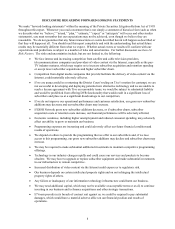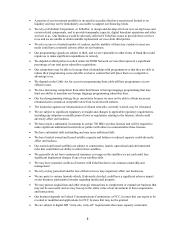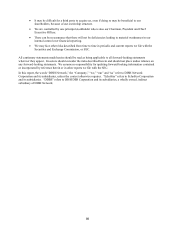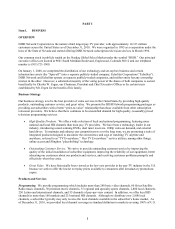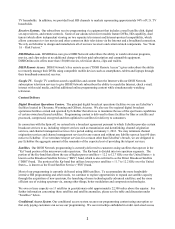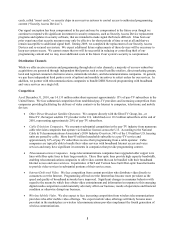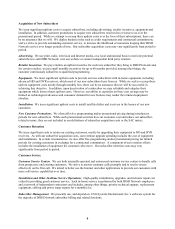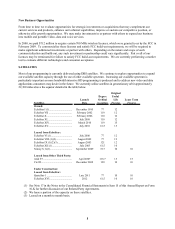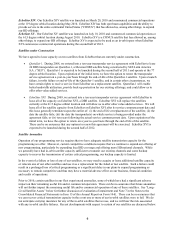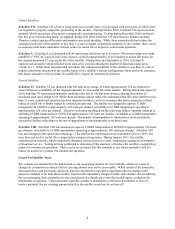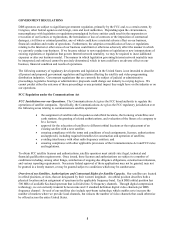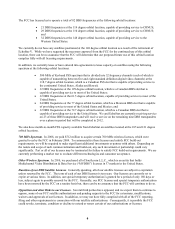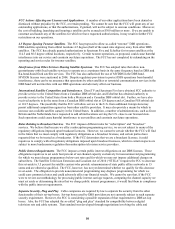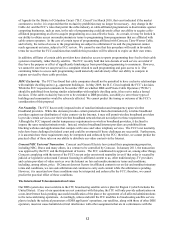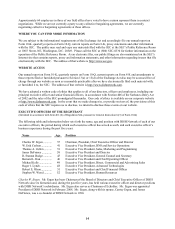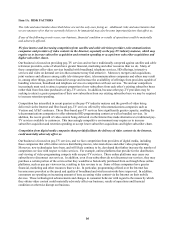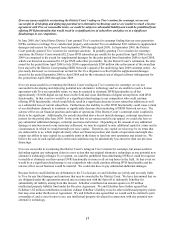Dish Network 2010 Annual Report Download - page 14
Download and view the complete annual report
Please find page 14 of the 2010 Dish Network annual report below. You can navigate through the pages in the report by either clicking on the pages listed below, or by using the keyword search tool below to find specific information within the annual report.7
7
Owned Satellites
EchoStar VII. EchoStar VII, which is being used as an in-orbit spare, was designed with four gyros, of which three
are required to properly control the positioning of the satellite. During October 2010, EchoStar VII experienced an
anomaly which caused one of its gyros to temporarily stop functioning. Testing during December 2010 confirmed
that this gyro is functioning again. In addition, during July 2010, EchoStar VII experienced a thruster anomaly.
Thrusters control spacecraft location and maintain spacecraft pointing. While these anomalies did not reduce the
estimated useful life of the satellite to less than 12 years or impact commercial operation of the satellite, there can be
no assurance that future anomalies will not reduce its useful life or impact its commercial operation.
EchoStar X. EchoStar X was designed with 49 spot beams which use up to 42 active 140 watt traveling wave tube
amplifiers (“TWTAs”) and 24 solar array circuits, of which approximately 22 are required to assure full power for
the original minimum 12-year useful life of the satellite. During May and September of 2010, EchoStar X
experienced anomalies which affected seven solar array circuits reducing the number of functional solar array
circuits to 17. While these anomalies did not reduce the estimated useful life of the satellite to less than 12 years or
impact commercial operation of the satellite based on the satellite’s current configuration, there can be no assurance
that future anomalies will not reduce its useful life or impact its commercial operation.
Leased Satellites
EchoStar VI. EchoStar VI was designed with 108 solar array strings, of which approximately 102 are required to
assure full power availability for the original minimum 12-year useful life of the satellite. During March and August of
2010, EchoStar VI experienced anomalies resulting in the loss of 24 solar array strings, reducing the number of
functional solar array strings to 84. While these anomalies did not reduce the estimated useful life of the satellite to less
than 12 years, commercial operation has been impacted and there can be no assurance that future anomalies will not
reduce its useful life or further impact its commercial operation. The satellite was designed to operate 32 DBS
transponders in CONUS at approximately 125 watts per channel, switchable to 16 DBS transponders operating at
approximately 250 watts per channel. The power reduction resulting from the solar array failures currently limits us to
operating 24 DBS transponders in CONUS at approximately 125 watts per channel, switchable to 12 DBS transponders
operating at approximately 250 watts per channel. The number of transponders to which power can be provided is
expected to decline in the future at the rate of approximately one transponder every three years.
EchoStar VIII. EchoStar VIII was designed to operate 32 DBS transponders in CONUS at approximately 120 watts
per channel, switchable to 16 DBS transponders operating at approximately 240 watts per channel. EchoStar VIII
was also designed with spot-beam technology. This satellite has experienced several anomalies prior to 2011, but
none have reduced its useful life or impacted its commercial operation. During January 2011, the satellite
experienced an anomaly, which temporarily disrupted electrical power to some components causing an interruption
of broadcast service. Testing is being performed to determine if this anomaly will reduce the satellite’s useful life or
impact its commercial operations. There can be no assurance that this anomaly or any future anomalies will not
reduce its useful life or impact its commercial operation.
Long-Lived Satellite Assets
We evaluate our satellite fleet for impairment as one asset group and test for recoverability whenever events or
changes in circumstances indicate that its carrying amount may not be recoverable. While certain of the anomalies
discussed above, and previously disclosed, may be considered to represent a significant adverse change in the
physical condition of an individual satellite, based on the redundancy designed within each satellite and considering
the asset grouping, these anomalies are not considered to be significant events that would require evaluation for
impairment recognition. Unless and until a specific satellite is abandoned or otherwise determined to have no
service potential, the net carrying amount related to the satellite would not be written off.



